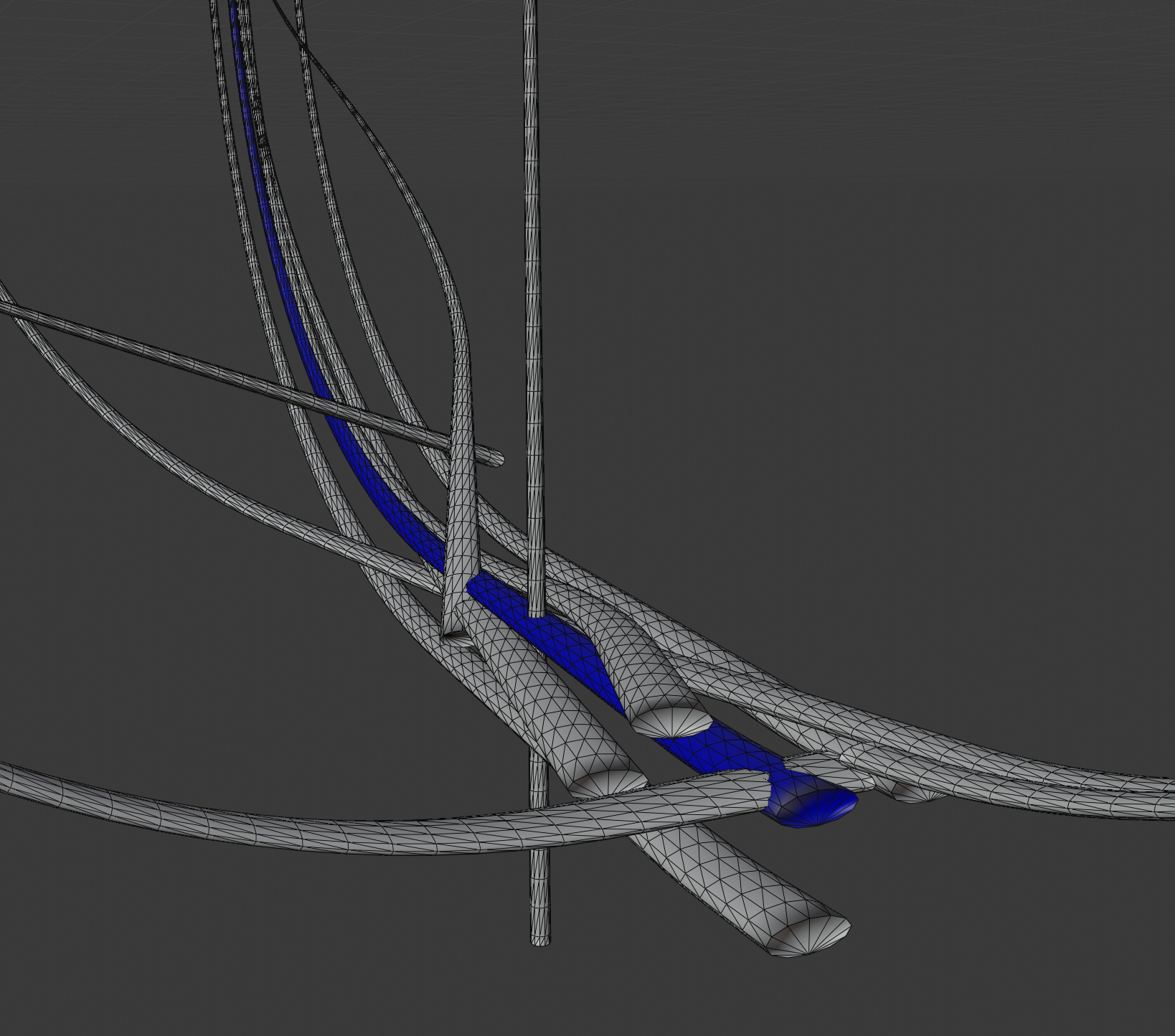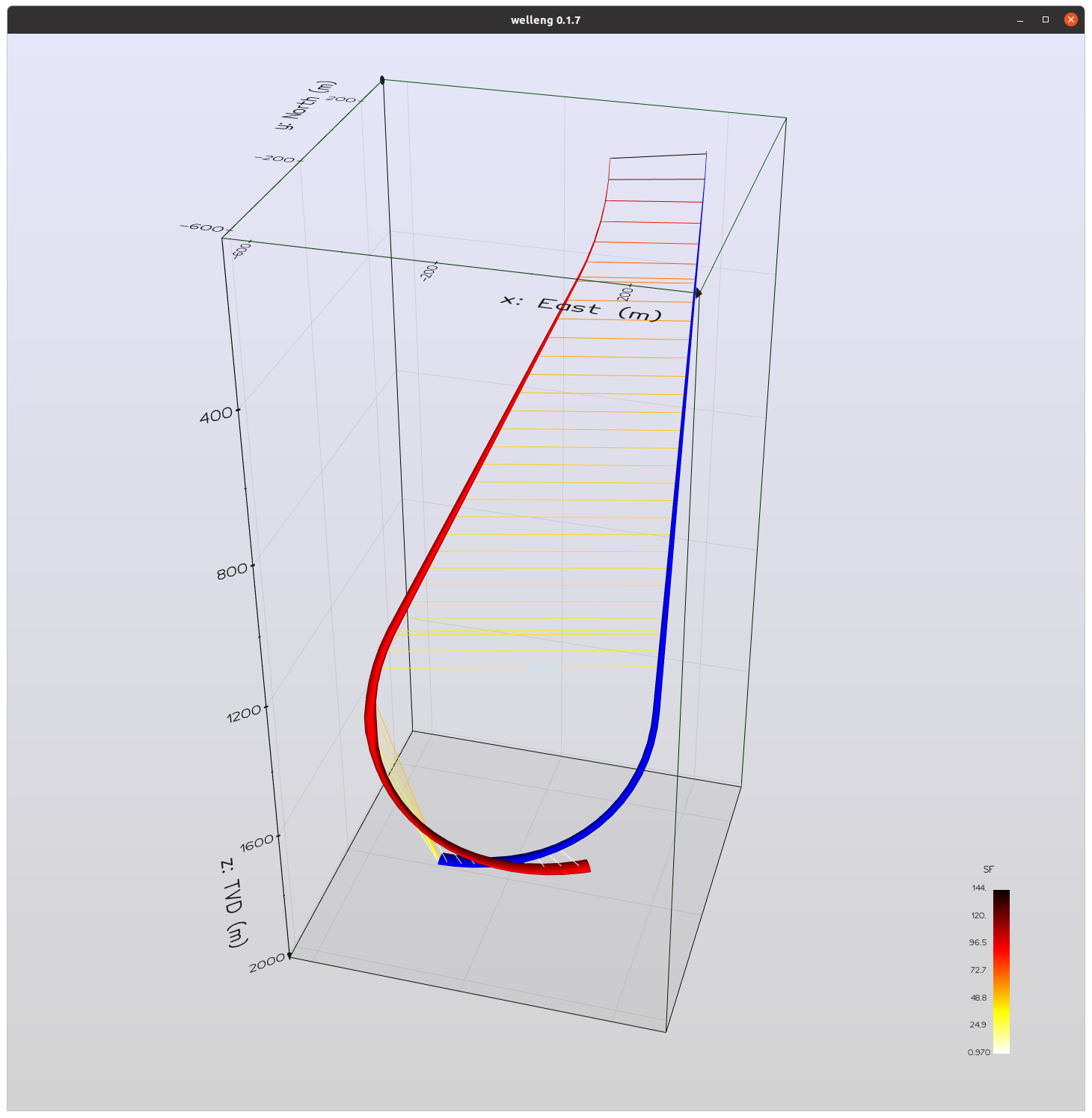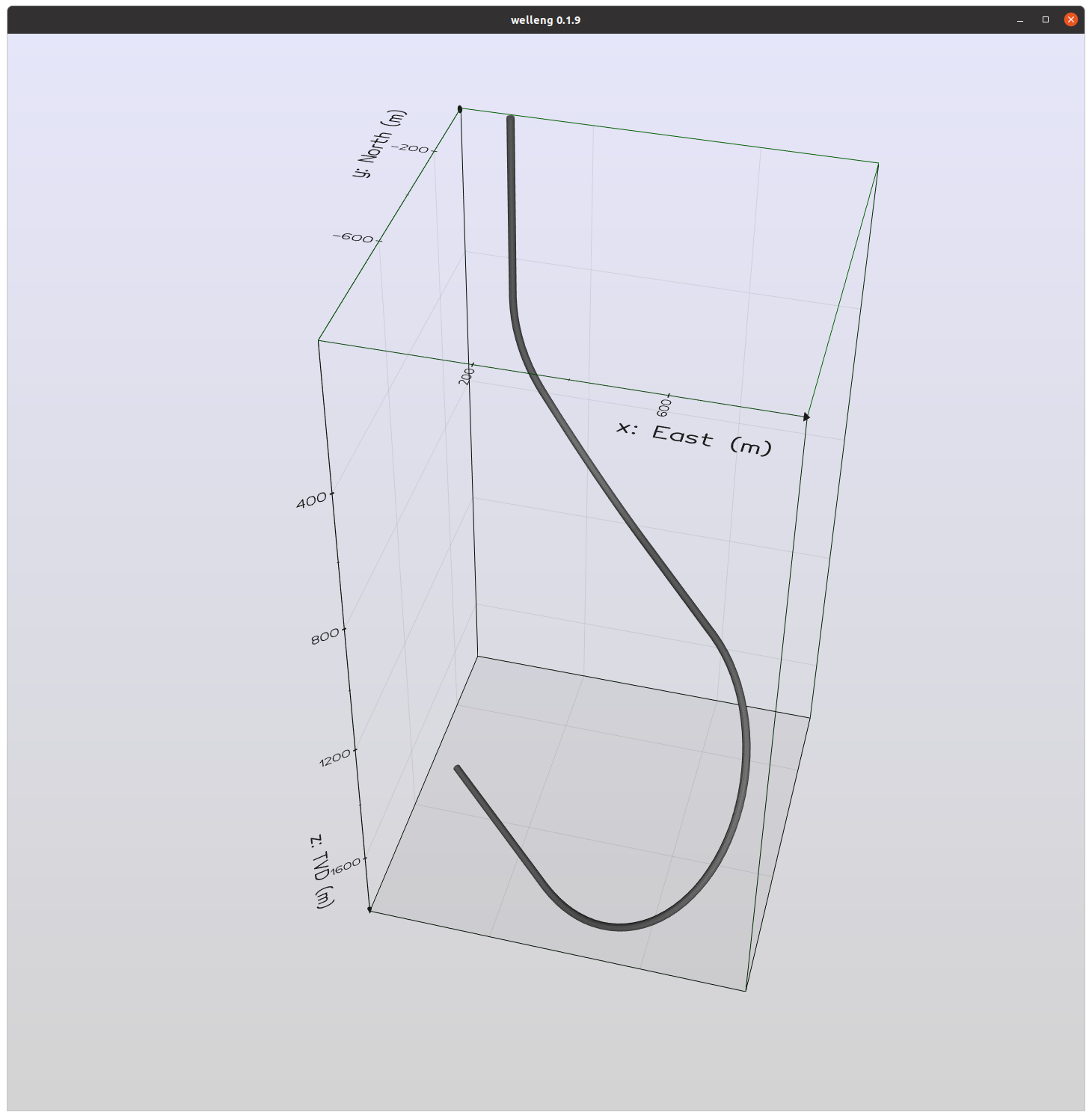A collection of Well Engineering tools
Project description
welleng
welleng aspires to be a collection of useful tools for Wells/Drilling Engineers, kicking off with a range of well trajectory tools.
- Generate survey listings and interpolation with minimum curvature
- Calculate well bore uncertainty data (utilizing either the ISCWSA MWD Rev4 or Rev5 models) - the coded error models are within 0.001% accuracy of the ISCWSA test data.
- Calculate well bore clearance and Separation Factors (SF)
- standard ISCWSA method within 0.5% accuracy of the ISCWSA test data.
- new mesh based method using the Flexible Collision Library.
Support welleng
welleng is fuelled by copious amounts of coffee, so if you wish to supercharge development please donate generously:
New Features!
- World Magnetic Model Calculator: calculates magnetic field data from the World Magnetic Model if magnetic field strength is not provided with the survey data.
- ISCWSA MWD Rev5 error model: added the latest ISCWSA error model that includes tortuousity effects on location uncertainty.
- Import from Landmark .wbp files: using the
exchange.wbpmodule it's now possible to import .wbp files exported from Landmark's COMPASS or DecisionSpace software.
import welleng as we
wp = we.exchange.wbp.load("demo.wbp") # import file
survey = we.exchange.wbp.wbp_to_survey(wp, step=30) # convert to survey
mesh = we.mesh.WellMesh(survey, method='circle') # convert to mesh
we.visual.plot(mesh.mesh) # plot the mesh
- Export to .wbp files (experiemental): using the
exchange.wbpmodule, it's possible to convert a planned survey file into a list of turn points that can be exported to a .wbp file.
import welleng as we
wp = we.exchange.wbp.WellPlan(survey) # convert Survey to WellPlan object
doc = we.exchange.wbp.export(wp) # create a .wbp document
we.exchange.wbp.save_to_file(doc, "demo.wbp") # save the document to file
- Well Path Creation: the addition of the
connectormodule enables drilling well paths to be created simply by providing start and end locations (with some vector data like inclination and azimuth). No need to indicate how to connect the points, the module will figure that out itself. - Fast visualization of well trajectory meshes: addition of the
visualmodule for quick and simple viewing and QAQC of well meshes. - Mesh Based Collision Detection: the current method for determining the Separation Factor between wells is constrained by the frequency and location of survey stations or necessitates interpolation of survey stations in order to determine if Anti-Collision Rules have been violated. Meshing the well bore interpolates between survey stations and as such is a more reliable method for identifying potential well bore collisions, especially wth more sparse data sets.
- More coming soon!
Tech
welleng uses a number of open source projects to work properly:
- trimesh - awesome library for loading and using triangular meshes
- numpy - the fundamental package for scientific computing with Python
- scipy - a Python-based ecosystem of open-source software for mathematics, science, and engineering
- vedo - a python module for scientific visualization, analysis of 3D objects and point clouds based on VTK.
- magnetic-field-calculator - a Python API for the British Geological Survey magnetic field calculator.
Installation
welleng requires trimesh, numpy and scipy to run. Other libraries are optional depending on usage and to get python-fcl running on which trimesh is built may require some additional installations. Other than that, it should be an easy pip install to get up and running with welleng and the minimum dependencies.
Ubuntu
Here's how to get the trickier dependencies manually installed on Ubuntu (further instructions can be found here):
sudo apt-get update
sudo apt-get install libeigen3-dev libccd-dev octomap-tools
On a Mac you should be able to install the above with brew and on a Windows machine you'll probably have to build these libraries following the instruction in the link, but it's not too tricky. Once the above are installed, then it should be a simple:
pip install welleng
For developers, the repository can be cloned and locally installed in your GitHub directory via your preferred Python env (the dev branch is usuall a version or two ahead of the main).
git clone https://github.com/jonnymaserati/welleng.git
cd welleng
pip install -e .
Make sure you include that . in the final line (it's not a typo) as this ensures that any changes to your development version are immediately implemented on save.
Windows
Detailed instructions for installing welleng in a Windows OS can be found in this post.
Colaboratory
Perhaps the simplest way of getting up and running with welleng is to with a colab notebook. The required dependencies can be installed with the following cell:
!apt-get install -y xvfb x11-utils libeigen3-dev libccd-dev octomap-tools
!pip install welleng plotly jupyter-dash
!pip install -U git+https://github.com/Kitware/ipyvtk-simple.git
Unfortunately the visualization doesn't work with colab (or rather I've not been able to embed a VTK object) so some further work is needed to view the results. However, the welleng engine can be used to generate data in the notebook. Test it out with the following code:
import welleng as we
import plotly.graph_objects as go
from jupyter_dash import JupyterDash
)
# create a survey
s = we.survey.Survey(
md=[0., 500., 2000., 5000.],
inc=[0., 0., 30., 90],
azi=[0., 0., 30., 90.,],
error_model='iscwsa_mwd_rev4'
)
# interpolate survey - generate points every 30 meters
s_interp = we.connector.interpolate_survey(s, step=30)
# plot the results
fig = go.Figure()
fig.add_trace(
go.Scatter3d(
x=s_interp.x,
y=s_interp.y,
z=s_interp.z,
mode='lines',
line=dict(
color='blue'
),
name='survey_interpolated'
),
)
fig.add_trace(
go.Scatter3d(
x=s.x,
y=s.y,
z=s.z,
mode='markers',
marker=dict(
color='red'
),
name='survey'
)
)
fig.update_scenes(zaxis_autorange="reversed")
fig.show()
Quick Start
Here's an example using welleng to construct a couple of simple well trajectories with the connector module, creating survey listings for the wells with well bore uncertainty data, using these surveys to create well bore meshes and finally printing the results and plotting the meshes with the closest lines and SF data.
import welleng as we
from tabulate import tabulate
# construct simple well paths
print("Constructing wells...")
connector_reference = we.connector.Connector(
pos1=[0., 0., 0.],
inc1=0.,
azi1=0.,
pos2=[-100., 0., 2000.],
inc2=90,
azi2=60,
).survey(step=50)
connector_offset = we.connector.Connector(
pos1=[0., 0., 0.],
inc1=0.,
azi1=225.,
pos2=[-280., -600., 2000.],
inc2=90.,
azi2=270.,
).survey(step=50)
# make survey objects and calculate the uncertainty covariances
print("Making surveys...")
sh_reference = we.survey.SurveyHeader(
name="reference",
azi_reference="grid"
)
survey_reference = we.survey.Survey(
md=connector_reference.md,
inc=connector_reference.inc_deg,
azi=connector_reference.azi_grid_deg,
header=sh_reference,
error_model='iscwsa_mwd_rev4'
)
sh_offset = we.survey.SurveyHeader(
name="offset",
azi_reference="grid"
)
survey_offset = we.survey.Survey(
md=connector_offset.md,
inc=connector_offset.inc_deg,
azi=connector_offset.azi_grid_deg,
start_nev=[100., 200., 0.],
header=sh_offset,
error_model='iscwsa_mwd_rev4'
)
# generate mesh objects of the well paths
print("Generating well meshes...")
mesh_reference = we.mesh.WellMesh(
survey_reference
)
mesh_offset = we.mesh.WellMesh(
survey_offset
)
# determine clearances
print("Setting up clearance models...")
c = we.clearance.Clearance(
survey_reference,
survey_offset
)
print("Calculating ISCWSA clearance...")
clearance_ISCWSA = we.clearance.ISCWSA(c)
print("Calculating mesh clearance...")
clearance_mesh = we.clearance.MeshClearance(c, sigma=2.445)
# tabulate the Separation Factor results and print them
results = [
[md, sf0, sf1]
for md, sf0, sf1
in zip(c.reference.md, clearance_ISCWSA.SF, clearance_mesh.SF)
]
print("RESULTS\n-------")
print(tabulate(results, headers=['md', 'SF_ISCWSA', 'SF_MESH']))
# get closest lines between wells
lines = we.visual.get_lines(clearance_mesh)
# plot the result
we.visual.plot(
[mesh_reference.mesh, mesh_offset.mesh], # list of meshes
names=['reference', 'offset'], # list of names
colors=['red', 'blue'], # list of colors
lines=lines
)
print("Done!")
This results in a quick, interactive visualization of the well meshes that's great for QAQC. What's interesting about these results is that the ISCWSA method does not explicitly detect a collision in this scenario wheras the mesh method does.
For more examples, including how to build a well trajectory by joining up a series of sections created with the welleng.connector module (see pic below), check out the examples.
Well trajectory generated by build_a_well_from_sections.py
Todos
- Add a Target class to see what you're aiming for - in progress
- Documentation
- Generate a scene of offset wells to enable fast screening of collision risks (e.g. hundreds of wells in seconds)
- More error models - added the ISCWSA MWD Rev5 error model
- WebApp for those that just want answers
It's possible to generate data for visualizing well trajectories with welleng, as can be seen with the rendered scenes below.

The ISCWSA standard set of well paths for evaluating clearance scenarios have been rendered in blender above. See the examples for the code used to generate a volve scene, extracting the data from the volve EDM.xml file.
License
Please note the terms of the license. Although this software endeavors to be accurate, it should not be used as is for real wells. If you want a production version or wish to develop this software for a particular application, then please get in touch with jonnycorcutt, but the intent of this library is to assist development.
Project details
Release history Release notifications | RSS feed
Download files
Download the file for your platform. If you're not sure which to choose, learn more about installing packages.



















